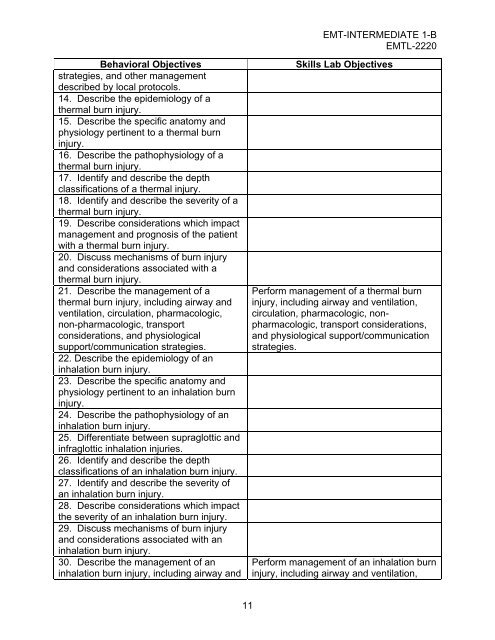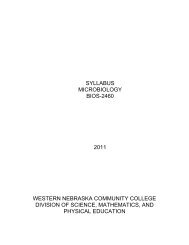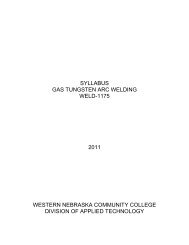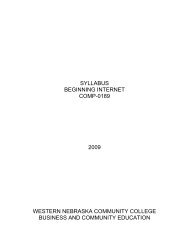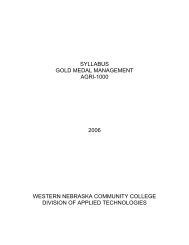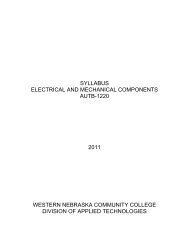View Current Syllabus - Western Nebraska Community College
View Current Syllabus - Western Nebraska Community College
View Current Syllabus - Western Nebraska Community College
You also want an ePaper? Increase the reach of your titles
YUMPU automatically turns print PDFs into web optimized ePapers that Google loves.
EMT-INTERMEDIATE 1-B<br />
EMTL-2220<br />
Behavioral Objectives<br />
strategies, and other management<br />
described by local protocols.<br />
14. Describe the epidemiology of a<br />
thermal burn injury.<br />
15. Describe the specific anatomy and<br />
physiology pertinent to a thermal burn<br />
injury.<br />
16. Describe the pathophysiology of a<br />
thermal burn injury.<br />
17. Identify and describe the depth<br />
classifications of a thermal injury.<br />
18. Identify and describe the severity of a<br />
thermal burn injury.<br />
19. Describe considerations which impact<br />
management and prognosis of the patient<br />
with a thermal burn injury.<br />
20. Discuss mechanisms of burn injury<br />
and considerations associated with a<br />
thermal burn injury.<br />
21. Describe the management of a<br />
thermal burn injury, including airway and<br />
ventilation, circulation, pharmacologic,<br />
non-pharmacologic, transport<br />
considerations, and physiological<br />
support/communication strategies.<br />
22. Describe the epidemiology of an<br />
inhalation burn injury.<br />
23. Describe the specific anatomy and<br />
physiology pertinent to an inhalation burn<br />
injury.<br />
24. Describe the pathophysiology of an<br />
inhalation burn injury.<br />
25. Differentiate between supraglottic and<br />
infraglottic inhalation injuries.<br />
26. Identify and describe the depth<br />
classifications of an inhalation burn injury.<br />
27. Identify and describe the severity of<br />
an inhalation burn injury.<br />
28. Describe considerations which impact<br />
the severity of an inhalation burn injury.<br />
29. Discuss mechanisms of burn injury<br />
and considerations associated with an<br />
inhalation burn injury.<br />
30. Describe the management of an<br />
inhalation burn injury, including airway and<br />
Skills Lab Objectives<br />
Perform management of a thermal burn<br />
injury, including airway and ventilation,<br />
circulation, pharmacologic, nonpharmacologic,<br />
transport considerations,<br />
and physiological support/communication<br />
strategies.<br />
Perform management of an inhalation burn<br />
injury, including airway and ventilation,<br />
11


